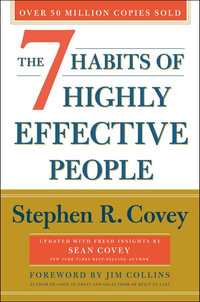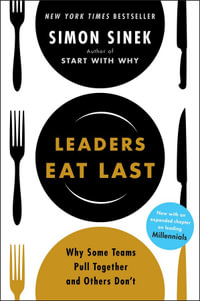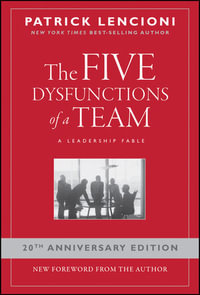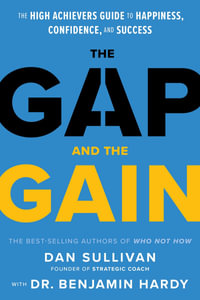
Leveraging the Power of Servant Leadership
Building High Performing Organizations
By: James Laub
Hardcover | 13 August 2018
At a Glance
364 Pages
21.01 x 14.81 x 2.06
Hardcover
$233.71
or 4 interest-free payments of $58.43 with
orAims to ship in 7 to 10 business days
This opening chapter introduces the power and potential along with the danger and horror of leadership. Archimedes' principle of the lever is introduced to serve as a central organizing metaphor for the book. Each of the five parts of the metaphor is summarized along with the key basic assumptions of the book.
Headings:
o The Purpose of Leadership
o The Danger and Horror of Leadership
o The Power and Beauty of Leadership
o Archimedes and the Lever
o Work and Leadership - the limits of force
o Unfolding the metaphor of the Lever
o The Object to be Moved (the purpose of leadership)
o The Leader (Applying Power in the Most Effective Way)
o The Fulcrum (Choosing your Leadership Mindset)
o The Lever (Utilizing Leadership Theories)
o A Place to Stand (The Practice of Leadership)
o Six Assumptions about Leadership
o World-moving Leadership
o Reflection Questions
Chapter 2: Defining Leadership: The Critical Role of Definition Making
This chapter makes a strong case for defining leadership terms and then using our definitions consistently to explain, teach and research effectively. In the process a typology of leadership is presented to deal with the key confusion points that continue to plague ongoing discussions of leadership. The goal is to make leadership and servant leadership a concept that is an understandable, observable and measurable reality that can be practiced effectively and taught to and developed in people. The 4-I model is presented to provide a visual way of understanding this typology in the context of real life along with leadership examples to be evaluated and assessed within the typology offered.
Headings:
o Introduction - Identifying the Problem
o The Importance of Definition-Making
o Identifying the Confusion Points - 7 Key Questions
o Criteria for a Good Definition
o Scenarios of Leadership: You be the Judge
o A Typology of Key Leadership Terms
o Defining Servant Leadership
o The 4-I Model of Leading
o Assessing your Leadership and Management behavior
o Reflection Questions
Chapter 3: The Leadership Story: Tracking the Threads of History
The progression of leadership thinking is tracked throughout history told in the form of story. Beginning with the family unit then moving through tribalism and the emergence of all-powerful kings, Plato's philosopher king and the Tao Te Ching, the leadership thoughts of Jesus and Machievelli, the chapter then leads up to the formalization of leadership thinking in the 20th century into the 21st century summarizing the development of leadership thought. The "threads of history" tracked through this story are the autocratic, servant and paternalistic mindsets of leadership.
Headings:
o Leadership in the Family, Bands and Tribes
o Leadership in Chiefdoms and Emerging Nations
o Rehoboam and The Leadership Choice
o Leadership in Nation/States (Agrarian Era)
o Organizational Leadership (Industrial Era)
o The 20th Century - Leadership's Search for a Distinct Voice
o The 21st Century - Making the Distinctions Clear<
o A Cautionary Tale
o Reflection Questions
Chapter 4: The Mindsets of Leadership: The A-P-S Model
As seen in the leadership story from chapter three, there have always existed three distinct mindsets of leadership; autocratic, paternalistic and servant. It is the choice of all leaders as to which paradigm they will adopt. Becoming aware of the existence of these mindsets is the first necessary step in the process. Each mindset is explained and contrasted and the discovery of the paternalistic mindset is highlighted as representing the majority of leadership practice today. The concept of the mindset (paradigm) is presented and then applied to leadership thinking.
Headings:
o What is a leadership mindset?
o Contrasting the Autocratic and the Servant Leader
o Discovering the Paternalistic Mindset
o Research and predominate mindsets in organizations today
o Reflection Questions
Chapter 5: The Toxic Leader - Exposing the Autocratic Mindset
Recent studies on leadership have focused on "Bad" leadership and the cost of self-focused autocratic leaders on organizations. Some see in the world today a move back toward authoritarianism as a guiding structure for political leadership. Autocratic leadership uses a leader's power and authority over others to seek the good that the leader envisions. It is a formula for leadership that makes sense when all that is sought is a desired outcome but the damage done by toxic leaders is immense and must be factored into the end result of this approach to leadership.
Headings:
o Toxic Leadership and the Rise of Authoritarianism
o The Ethics of Self vs. Others
o Autocratic Leadership Expressions
o Narcissistic Leaders
o Addictive Leaders
o Self-Absorbed Leaders
o Machiavelli - the patron saint of Autocratic Leadership
o When the Leader is the Focus of Leadership
o Reflection Questions
Chapter 6: The Parental Leader - Exploring the Paternalistic Mindset
Recent research has shown that the most prevalent mindset of leadership being practiced today is paternalistic. The view of the leader as parent and the followers as children goes mostly unrecognized and therefore unaddressed. Much of what is considered to be servant-oriented leadership is actually a form of positive paternalistic leadership. By understanding the implications of this mindset we can address its limitations and how it keeps followers from becoming leaders and leaders from becoming truly servant-oriented.
What is happening in paternalistic organizations today? What happens when leaders view themselves as a parent over children? One of the key implications is the establishing of reinforcing roles as explained by the Parent-Adult-Child (P-A-C Model). This model helps us to understand many of the dysfunctional dynamics occurring in leader/follower relationships and how these problems can be addressed. The paternalistic mindset of leaders will continue to reinforce the parent-child roles while the servant mindset will be based on healthy adult-adult partnership relationships.
Headings:
o Colonialism and Paternalism
o The limits of Paternalism as a Leadership Mindset
o Understanding Paternalistic Culture and Communication - the PAC model
o Learning Adult Speak - Resisting Paternalism
o Leadership Communication through the PAC model
o Reflection Questions
Chapter 7: The Servant Leader - Explaining the Servant Mindset
The research-based OLA model of servant leadership is presented including the six disciplines and the eighteen descriptors that describe servant leadership behavior. A clear and usable definition of servant leadership forms the foundation for understanding servant leadership as a mindset rather than merely another style (or option) of leadership. The OLA model presented is a practical and usable approach to understanding and assessing servant leadership in individuals as well as in organizations.
Headings:
o The OLA model of Servant Leadership - Research
o The Six Disciplines of the Servant Leader
o Displays Authenticity
o Values People
o Develops People
o Builds Community
o Provides Leadership
o Share Leadership
o Using the Model
o Identifying your Leadership Strengths and Weakness
o Interactions between the Disciplines
o Practicing Servant Leadership
o Other models of Servant Leadership -Greenleaf & Beyond
o Addressing Misconceptions of Servant Leadership
o Assessing your own Leadership Mindset
o Reflection Questions
Chapter 8: The Servant Organization
What makes an organization healthy? This chapter takes the concepts discussed so far in the book and applies them to organizations. The implications of autocratic, paternalistic or servant organizations is explored. The Organizational Leadership Assessment (OLA) is presented as well as the six levels of organizational health. Leaders will be able to assess the health of their own leadership and their organization through the use of this tool and model. A summary of research to date with the OLA will be shared showing the relationship between servant leadership and organizational performance.
Headings:
o The Institution as Servant - Greenleaf's Vision
o Six Levels of Organizational Health
o Toxic and Poor Health Organizations
o Negative Paternalistic Organizations
o Positive Paternalistic Organizations
o Servant-Healthy Organizations
o Servant Organizations as Healthy Organizations - a Review of Research
o Reflection Questions
Chapter 9: Servant Organizational Structures
Can servant leadership function effectively in different organizational structures? Might a servant leadership mindset help to support and even create new types of organizational forms that can take us beyond the limitations of authority based hierarchy? The work of Frederic Laloux will be examined to see how his model of Green and Teal organizations might be related to the servant leadership approach. Issues of self-managing teams, high-trust organizations and building leadership cultures are considered.
Headings:
o New Wine in Old Wineskins
o Is it Enough to Flip the Pyramid?
o A Developmental Approach to Organizational Structures
o Servant Organizations - Green or Teal?
o A Team Leader or a Team of Leaders?
o A Multi-Model Approach ... simplicity and complexity
o Reflection Questions
Chapter 10: Leveraging your Leadership Power
Personal power is defined as the ability of a person to act vs. the ability to get someone else to act. Therefore, it is essential that leaders understand how power is necessary for effective leadership. We have been so fearful of the abuse of power that we have often considered it in totally negative terms. One result of this is that individuals refuse to admit that they have personal leadership power and therefore must use that power to benefit and serve others. Various theories of power will be presented and contrasted to this practical and usable view of personal leveraged power.
Headings:
o What is Leadership Power and why must Servant Leaders Accept it and Use it?
o Clarifying terms related to Authority and Power
o The Bases of Power - Adding One More to the List
o Ethics, Servant Leadership and Power
o Why Leaders must use Power - Leveraged Power
o Reflection Questions
Chapter 11: Mindshifting - the Critical Thinking Leader
How does a leader shift their underlying perceptions about leadership? How might someone transform their thinking from an autocratic or paternalistic view to a servant-minded view? The mindshifts considered will deal with the leader's view of him or herself, the leader's view of the led and the leader's view of the true purpose of leadership. Models of critical thinking will be applied to the practical challenge of addressing and changing our mental models to be able to leverage our servant leadership power.
Headings:
o The Critical Thinking Leader
o Identifying your Leadership Mindset
o Transforming your Leadership Mindset
o What a Servant Mindset Requires of the Leader - moving beyond nice
o Reflection Questions
Chapter 12: Conclusion - Moving the World - One Leadership Act at a Time
In this final chapter, we will pull together the various parts of the metaphor of the lever to reinforce key concepts of the book. Leadership can be performed in a more positive and effective way. We can change the world through our bold acts of leading and others will be changed positively through the process. Each of us has the capacity and the responsibility to lead to move the world to a better place. This chapter will emphasize the call of leadership for us all and the challenge to answer that call to make a lasting difference in the world.
The effective practice of leadership will be addressed by relating leadership to both organizational life and the interior life of the leader. Key leadership skills will be addressed with an emphasis on the assumption that leaders lead out of who they are. Our leadership effectiveness will be affected by our inner resources as well as the organizational context we choose to participate in to fulfill our personal vision.
Headings:
o The Call of Servant Leadership
o Moving from Research to Performance
o Leading out of Who You Are - Finding a Place to Stand
o Leveraging your Leadership Power
o Leadership that Moves the World - The Man Who Planted Trees
o Greatness Redefined
o Reflection Questions
Appendices:
o T The OLA instrument (organizational assessment)
o TThe Six Health Levels Brief
o TThe OLA Self-assessment instrument
o TThe Six Health Levels Expanded
o LLeadership vs. Management Survey
ISBN: 9783319771427
ISBN-10: 3319771426
Series: Palgrave Studies in Workplace Spirituality and Fulfillment
Published: 13th August 2018
Format: Hardcover
Language: English
Number of Pages: 364
Audience: Professional and Scholarly
Publisher: Springer Nature B.V.
Country of Publication: CH
Dimensions (cm): 21.01 x 14.81 x 2.06
Weight (kg): 0.59
Shipping
| Standard Shipping | Express Shipping | |
|---|---|---|
| Metro postcodes: | $9.99 | $14.95 |
| Regional postcodes: | $9.99 | $14.95 |
| Rural postcodes: | $9.99 | $14.95 |
How to return your order
At Booktopia, we offer hassle-free returns in accordance with our returns policy. If you wish to return an item, please get in touch with Booktopia Customer Care.
Additional postage charges may be applicable.
Defective items
If there is a problem with any of the items received for your order then the Booktopia Customer Care team is ready to assist you.
For more info please visit our Help Centre.
You Can Find This Book In

Scaling Up (Revised 2022)
How a Few Companies Make It...and Why the Rest Don't (Rockefeller Habits 2.0)
Paperback
RRP $41.79
$27.50
OFF























